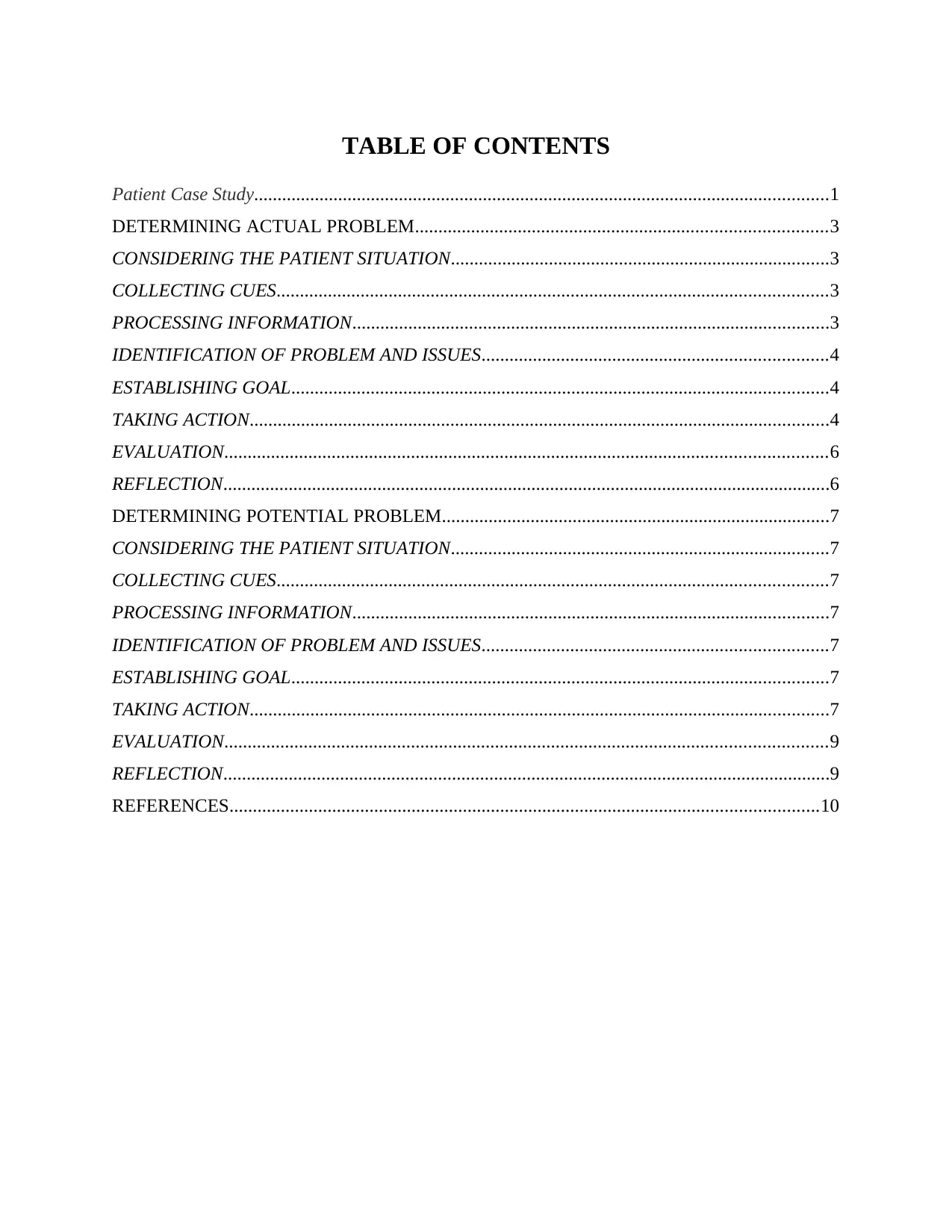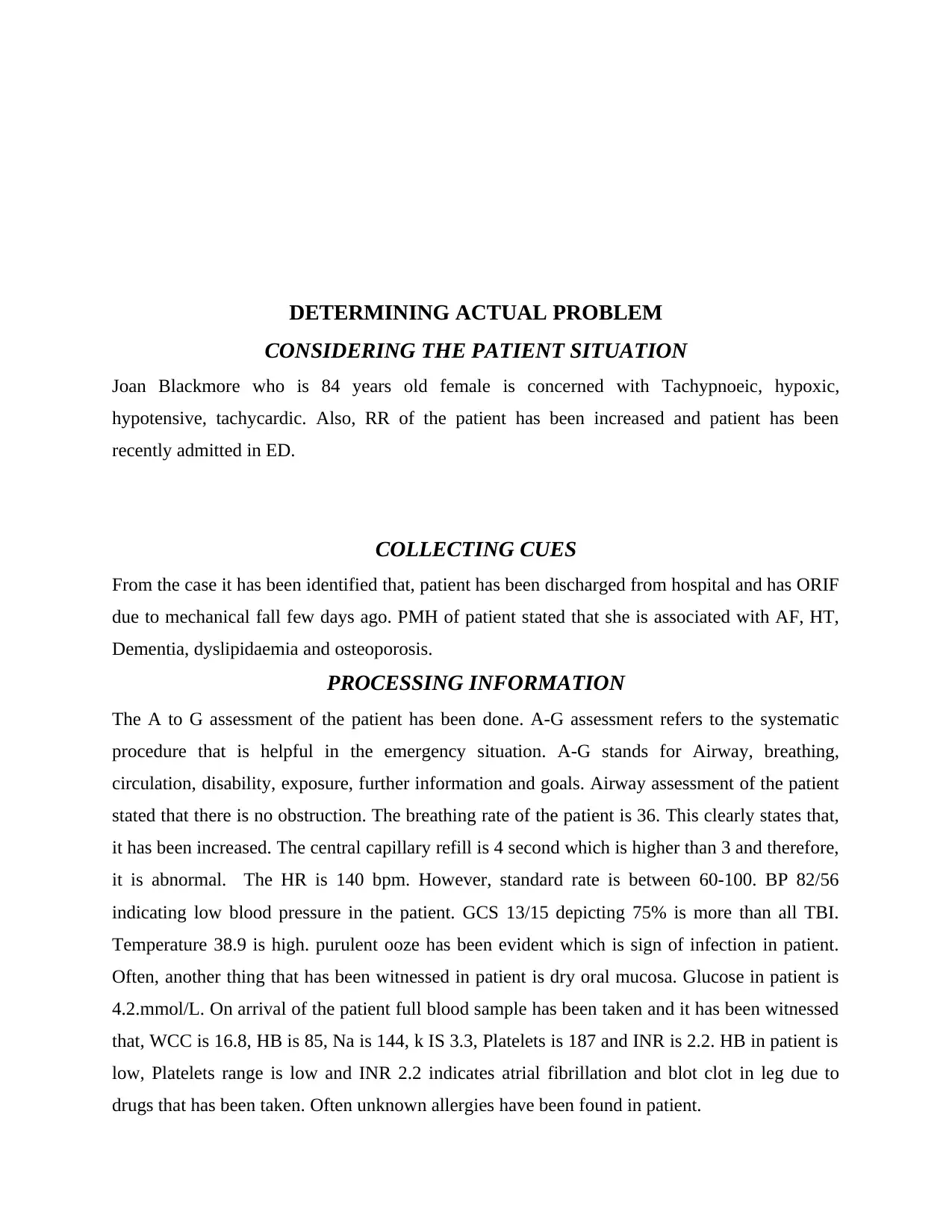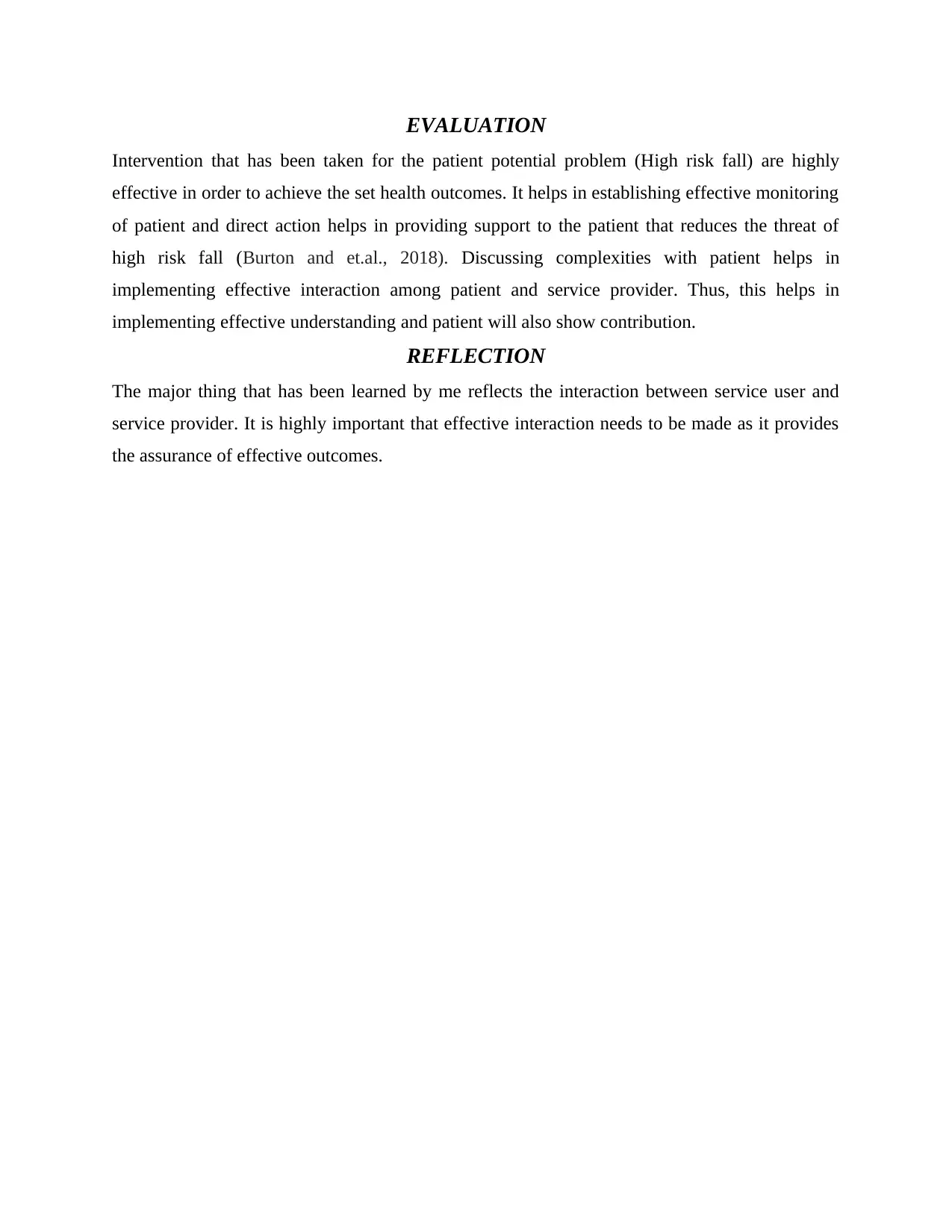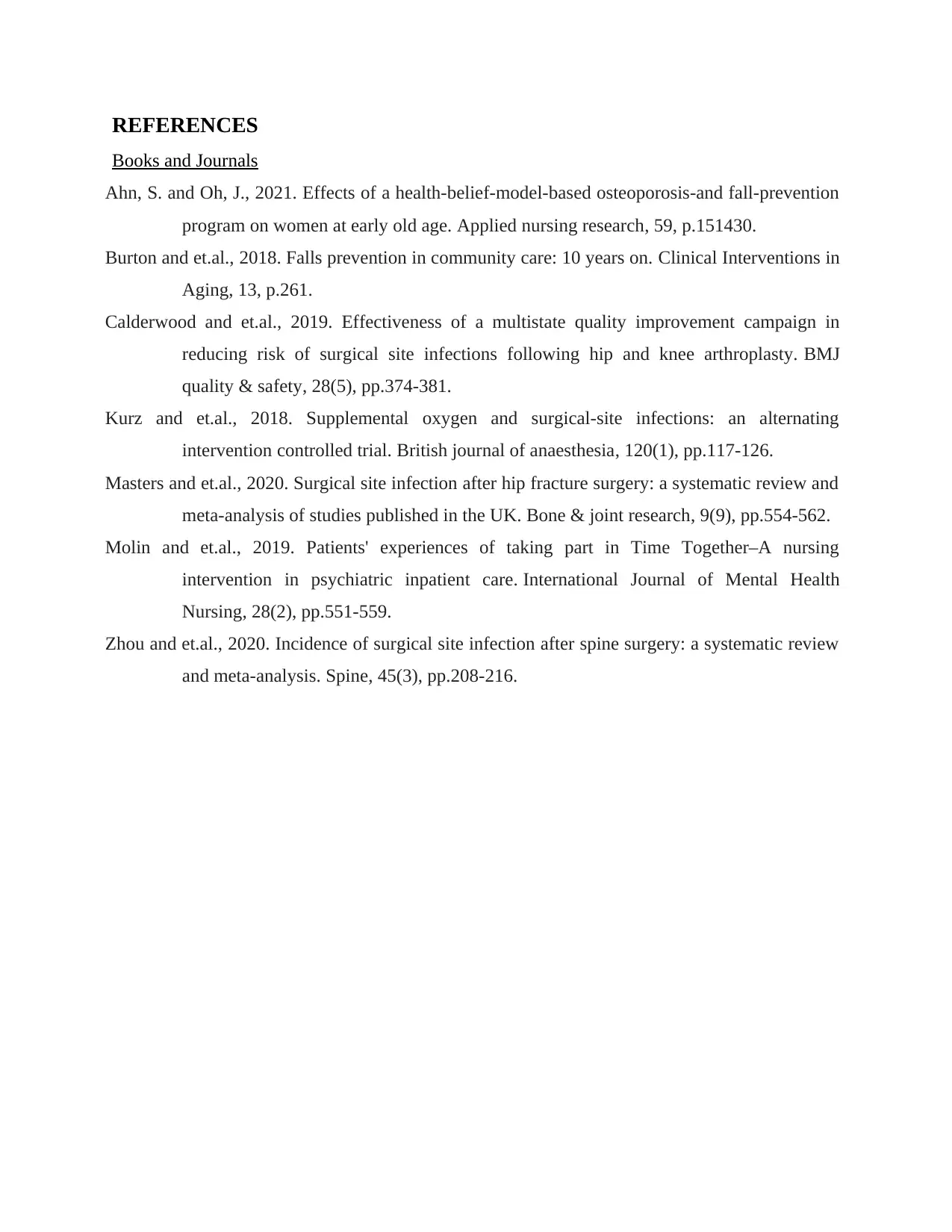Patient Case Study: Complex Nursing Care for Joan Blackmore in ED
VerifiedAdded on 2023/06/10
|11
|2058
|129
Case Study
AI Summary
This case study analyzes the presentation of Joan Blackmore, an 84-year-old female admitted to the Emergency Department (ED) with tachypnea, hypoxia, hypotension, and tachycardia, following a recent hip surgery and a history of multiple comorbidities. The assessment, based on the provided information, identifies a surgical site infection as the actual problem, detailing cues, processing of information using the A-G assessment, problem identification, establishing goals focused on preventing the spread of infection, and outlining nursing interventions such as oxygen supplementation, antibiotic administration, and regular wound assessment. A potential problem of high fall risk, linked to her dementia, is also addressed, with interventions including patient monitoring, secure beds, and patient education. The study emphasizes the importance of effective nursing interventions, regular evaluation, and reflection on the patient's condition, highlighting the need for a comprehensive approach to patient care in a complex medical scenario. References from various sources are used to support the analysis and the proposed interventions.

Patient Case Study
Paraphrase This Document
Need a fresh take? Get an instant paraphrase of this document with our AI Paraphraser

TABLE OF CONTENTS
Patient Case Study...........................................................................................................................1
DETERMINING ACTUAL PROBLEM........................................................................................3
CONSIDERING THE PATIENT SITUATION.................................................................................3
COLLECTING CUES......................................................................................................................3
PROCESSING INFORMATION......................................................................................................3
IDENTIFICATION OF PROBLEM AND ISSUES..........................................................................4
ESTABLISHING GOAL...................................................................................................................4
TAKING ACTION............................................................................................................................4
EVALUATION.................................................................................................................................6
REFLECTION..................................................................................................................................6
DETERMINING POTENTIAL PROBLEM...................................................................................7
CONSIDERING THE PATIENT SITUATION.................................................................................7
COLLECTING CUES......................................................................................................................7
PROCESSING INFORMATION......................................................................................................7
IDENTIFICATION OF PROBLEM AND ISSUES..........................................................................7
ESTABLISHING GOAL...................................................................................................................7
TAKING ACTION............................................................................................................................7
EVALUATION.................................................................................................................................9
REFLECTION..................................................................................................................................9
REFERENCES..............................................................................................................................10
Patient Case Study...........................................................................................................................1
DETERMINING ACTUAL PROBLEM........................................................................................3
CONSIDERING THE PATIENT SITUATION.................................................................................3
COLLECTING CUES......................................................................................................................3
PROCESSING INFORMATION......................................................................................................3
IDENTIFICATION OF PROBLEM AND ISSUES..........................................................................4
ESTABLISHING GOAL...................................................................................................................4
TAKING ACTION............................................................................................................................4
EVALUATION.................................................................................................................................6
REFLECTION..................................................................................................................................6
DETERMINING POTENTIAL PROBLEM...................................................................................7
CONSIDERING THE PATIENT SITUATION.................................................................................7
COLLECTING CUES......................................................................................................................7
PROCESSING INFORMATION......................................................................................................7
IDENTIFICATION OF PROBLEM AND ISSUES..........................................................................7
ESTABLISHING GOAL...................................................................................................................7
TAKING ACTION............................................................................................................................7
EVALUATION.................................................................................................................................9
REFLECTION..................................................................................................................................9
REFERENCES..............................................................................................................................10

DETERMINING ACTUAL PROBLEM
CONSIDERING THE PATIENT SITUATION
Joan Blackmore who is 84 years old female is concerned with Tachypnoeic, hypoxic,
hypotensive, tachycardic. Also, RR of the patient has been increased and patient has been
recently admitted in ED.
COLLECTING CUES
From the case it has been identified that, patient has been discharged from hospital and has ORIF
due to mechanical fall few days ago. PMH of patient stated that she is associated with AF, HT,
Dementia, dyslipidaemia and osteoporosis.
PROCESSING INFORMATION
The A to G assessment of the patient has been done. A-G assessment refers to the systematic
procedure that is helpful in the emergency situation. A-G stands for Airway, breathing,
circulation, disability, exposure, further information and goals. Airway assessment of the patient
stated that there is no obstruction. The breathing rate of the patient is 36. This clearly states that,
it has been increased. The central capillary refill is 4 second which is higher than 3 and therefore,
it is abnormal. The HR is 140 bpm. However, standard rate is between 60-100. BP 82/56
indicating low blood pressure in the patient. GCS 13/15 depicting 75% is more than all TBI.
Temperature 38.9 is high. purulent ooze has been evident which is sign of infection in patient.
Often, another thing that has been witnessed in patient is dry oral mucosa. Glucose in patient is
4.2.mmol/L. On arrival of the patient full blood sample has been taken and it has been witnessed
that, WCC is 16.8, HB is 85, Na is 144, k IS 3.3, Platelets is 187 and INR is 2.2. HB in patient is
low, Platelets range is low and INR 2.2 indicates atrial fibrillation and blot clot in leg due to
drugs that has been taken. Often unknown allergies have been found in patient.
CONSIDERING THE PATIENT SITUATION
Joan Blackmore who is 84 years old female is concerned with Tachypnoeic, hypoxic,
hypotensive, tachycardic. Also, RR of the patient has been increased and patient has been
recently admitted in ED.
COLLECTING CUES
From the case it has been identified that, patient has been discharged from hospital and has ORIF
due to mechanical fall few days ago. PMH of patient stated that she is associated with AF, HT,
Dementia, dyslipidaemia and osteoporosis.
PROCESSING INFORMATION
The A to G assessment of the patient has been done. A-G assessment refers to the systematic
procedure that is helpful in the emergency situation. A-G stands for Airway, breathing,
circulation, disability, exposure, further information and goals. Airway assessment of the patient
stated that there is no obstruction. The breathing rate of the patient is 36. This clearly states that,
it has been increased. The central capillary refill is 4 second which is higher than 3 and therefore,
it is abnormal. The HR is 140 bpm. However, standard rate is between 60-100. BP 82/56
indicating low blood pressure in the patient. GCS 13/15 depicting 75% is more than all TBI.
Temperature 38.9 is high. purulent ooze has been evident which is sign of infection in patient.
Often, another thing that has been witnessed in patient is dry oral mucosa. Glucose in patient is
4.2.mmol/L. On arrival of the patient full blood sample has been taken and it has been witnessed
that, WCC is 16.8, HB is 85, Na is 144, k IS 3.3, Platelets is 187 and INR is 2.2. HB in patient is
low, Platelets range is low and INR 2.2 indicates atrial fibrillation and blot clot in leg due to
drugs that has been taken. Often unknown allergies have been found in patient.
⊘ This is a preview!⊘
Do you want full access?
Subscribe today to unlock all pages.

Trusted by 1+ million students worldwide

IDENTIFICATION OF PROBLEM AND ISSUES
The available information of the patient is indicating the actual problem in patient is surgical site
infection. Surgical site infection (SSI) has been considered as the infection that takes place in
patient after the surgery has been taken place (Zhou and et.al., 2020). Available information
stated that patient has gone through ORIF to hip. Thus, surgical site infection has been occurred
in the patient. The pathophysiology of surgical site infection has been considered as the complex
procedure that is primed. Also, pre-triggered the host-immune inflammatory responds to the
pathogens. The load and the virulence of invades microbes in the surgical patient and impacts the
blood pressure rate. Germs infects the surgical wound within making contact if the proper care
has not been assured to the wound then it creates the infection. However, in context of Joan it has
been found that, she has unknown allergies and the mouth of the patient was dry and it is due to
yeast infection. The patient has surgical site infection and therefore, the A TO G assessment of
the patient has shown abnormalities.
ESTABLISHING GOAL
The heath outcome for the patient actual problem (Surgical site infection) is associated with the
“Prevention of spread of infection”.
TAKING ACTION
Nursing intervention refers to the set of action that has been taken in context of improving
the situation of patient. The nursing intervention helps in achieving the major health outcomes.
Nursing intervention has been developed on the basis of the current situation of the patient. The
major nursing intervention that needs to be adopted in context of given case are:
Intervention type Example Information
Direct action Supplying oxygen and
Providing antibiotics to patient
Supplement of oxygen is
appropriate in this case as high
inspired oxygen increases the
tissue oxygenation that kills
the bacteria that creates
The available information of the patient is indicating the actual problem in patient is surgical site
infection. Surgical site infection (SSI) has been considered as the infection that takes place in
patient after the surgery has been taken place (Zhou and et.al., 2020). Available information
stated that patient has gone through ORIF to hip. Thus, surgical site infection has been occurred
in the patient. The pathophysiology of surgical site infection has been considered as the complex
procedure that is primed. Also, pre-triggered the host-immune inflammatory responds to the
pathogens. The load and the virulence of invades microbes in the surgical patient and impacts the
blood pressure rate. Germs infects the surgical wound within making contact if the proper care
has not been assured to the wound then it creates the infection. However, in context of Joan it has
been found that, she has unknown allergies and the mouth of the patient was dry and it is due to
yeast infection. The patient has surgical site infection and therefore, the A TO G assessment of
the patient has shown abnormalities.
ESTABLISHING GOAL
The heath outcome for the patient actual problem (Surgical site infection) is associated with the
“Prevention of spread of infection”.
TAKING ACTION
Nursing intervention refers to the set of action that has been taken in context of improving
the situation of patient. The nursing intervention helps in achieving the major health outcomes.
Nursing intervention has been developed on the basis of the current situation of the patient. The
major nursing intervention that needs to be adopted in context of given case are:
Intervention type Example Information
Direct action Supplying oxygen and
Providing antibiotics to patient
Supplement of oxygen is
appropriate in this case as high
inspired oxygen increases the
tissue oxygenation that kills
the bacteria that creates
Paraphrase This Document
Need a fresh take? Get an instant paraphrase of this document with our AI Paraphraser

infection. Thus, this helps in
healing infection. Also,
Vancomycin can be used for
the patient in order to reduce
the threat of surgical infection.
This drug is highly useful in
treating the infection that has
been caused due to bacteria.
Thus, for patient this antibiotic
will be suitable that helps in
healing the wound that has
been created due to surgical
site infection.
Notification Informing healthcare experts In case, the infection starts
spreading on higher note then
it often requires another
surgery. Therefore, it is
important to inform the
healthcare experts. As
providing information on time
helps in assessing the major
health outcome. Furthermore,
it helps in timely prevention of
the surgery infection (Molin
and et.al., 2019).
Direct assessment Identification of swelling and
wound.
The range of infection needs
to be assess on daily basis as it
will provide idea about the
extent up-to which infection is
spreading (Masters and et.al.,
2020). Dressing needs to be
healing infection. Also,
Vancomycin can be used for
the patient in order to reduce
the threat of surgical infection.
This drug is highly useful in
treating the infection that has
been caused due to bacteria.
Thus, for patient this antibiotic
will be suitable that helps in
healing the wound that has
been created due to surgical
site infection.
Notification Informing healthcare experts In case, the infection starts
spreading on higher note then
it often requires another
surgery. Therefore, it is
important to inform the
healthcare experts. As
providing information on time
helps in assessing the major
health outcome. Furthermore,
it helps in timely prevention of
the surgery infection (Molin
and et.al., 2019).
Direct assessment Identification of swelling and
wound.
The range of infection needs
to be assess on daily basis as it
will provide idea about the
extent up-to which infection is
spreading (Masters and et.al.,
2020). Dressing needs to be

done on regular basis after
identifying monitoring the
wound.
Referral Seeking help from dietitian The patient has various
unknown allergies and often
old in age therefore, in order
to assure strength to the
patient helps from dietitian
needs to be taken. So, the food
cannot create any impact over
infection.
EVALUATION
The above section is stating the major interventions that has been taken for the patient in context
of achieving health outcome and reducing the surgery site infection. Antibiotic provide to patient
will help in reducing the threat of spreading of infection and also reduces the swelling and
problem of dry mouth. Along with this, it helps in reducing the pain as well. In case, the situation
become worse and infection starts getting spread in such situation the patient needs another
surgery that improves surgery site infection. Direct assessment of the patient on regular basis
helps in identifying the extent up-to which the wound has been healed or not. Furthermore, it will
help in taking another decision as well (Kurz and et.al., 2018). Thus, regular dressing of Joan
reduces the threat of bacteria contact at the infection place. Seeking help from dietitian helps in
providing only those food and drink to patient that solves the issues regarding blood pressure and
often helps in maintain certain allergies. This often provides the assurance of not impacting the
infection in negative manner.
REFLECTION
I understand that, it is highly important to know the current situation of the patient as it helps in
determining the major goal that is needed to achieve. Furthermore, it helps in determining the
identifying monitoring the
wound.
Referral Seeking help from dietitian The patient has various
unknown allergies and often
old in age therefore, in order
to assure strength to the
patient helps from dietitian
needs to be taken. So, the food
cannot create any impact over
infection.
EVALUATION
The above section is stating the major interventions that has been taken for the patient in context
of achieving health outcome and reducing the surgery site infection. Antibiotic provide to patient
will help in reducing the threat of spreading of infection and also reduces the swelling and
problem of dry mouth. Along with this, it helps in reducing the pain as well. In case, the situation
become worse and infection starts getting spread in such situation the patient needs another
surgery that improves surgery site infection. Direct assessment of the patient on regular basis
helps in identifying the extent up-to which the wound has been healed or not. Furthermore, it will
help in taking another decision as well (Kurz and et.al., 2018). Thus, regular dressing of Joan
reduces the threat of bacteria contact at the infection place. Seeking help from dietitian helps in
providing only those food and drink to patient that solves the issues regarding blood pressure and
often helps in maintain certain allergies. This often provides the assurance of not impacting the
infection in negative manner.
REFLECTION
I understand that, it is highly important to know the current situation of the patient as it helps in
determining the major goal that is needed to achieve. Furthermore, it helps in determining the
⊘ This is a preview!⊘
Do you want full access?
Subscribe today to unlock all pages.

Trusted by 1+ million students worldwide

major intervention for the patient. Next time, I would focus over analysing the ethical concern
related to the intervention as well.
DETERMINING POTENTIAL PROBLEM
CONSIDERING THE PATIENT SITUATION
The patient is under hospitalization and getting treatment in regards of surgical site infection.
Thus, effective focus needs to be provided over patient.
COLLECTING CUES
Information regarding patient stated that patient has Dementia.
PROCESSING INFORMATION
There may be possibility that due to dementia patient may forget about ongoing treatment and
the risk related to high fall can occur.
IDENTIFICATION OF PROBLEM AND ISSUES
The major potential problem that exist at the moment is related to the high risk fall. This refers to
the phase in which patient falls during the hospitalization. In context of given case study, it has
been analysed that, patient already had a surgery and now patient is facing surgical site infection.
Also, the patient has the problem of Dementia. it creates situation when patient face loss of nerve
cells. Thus, the major potential threat is related to high risk fall.
ESTABLISHING GOAL
The health outcome related to potential problem (High risk fall) is associated with reducing the
chances of falling, reducing the risk of injury and maintaining highest possible of mobility.
TAKING ACTION
Intervention type Example Information
Monitoring Allocating nurse to
patient.
Proper monitoring of the
patient needs to be done. So,
the patient cannot fall. In order
to provide effective care
services to patient a nurse
related to the intervention as well.
DETERMINING POTENTIAL PROBLEM
CONSIDERING THE PATIENT SITUATION
The patient is under hospitalization and getting treatment in regards of surgical site infection.
Thus, effective focus needs to be provided over patient.
COLLECTING CUES
Information regarding patient stated that patient has Dementia.
PROCESSING INFORMATION
There may be possibility that due to dementia patient may forget about ongoing treatment and
the risk related to high fall can occur.
IDENTIFICATION OF PROBLEM AND ISSUES
The major potential problem that exist at the moment is related to the high risk fall. This refers to
the phase in which patient falls during the hospitalization. In context of given case study, it has
been analysed that, patient already had a surgery and now patient is facing surgical site infection.
Also, the patient has the problem of Dementia. it creates situation when patient face loss of nerve
cells. Thus, the major potential threat is related to high risk fall.
ESTABLISHING GOAL
The health outcome related to potential problem (High risk fall) is associated with reducing the
chances of falling, reducing the risk of injury and maintaining highest possible of mobility.
TAKING ACTION
Intervention type Example Information
Monitoring Allocating nurse to
patient.
Proper monitoring of the
patient needs to be done. So,
the patient cannot fall. In order
to provide effective care
services to patient a nurse
Paraphrase This Document
Need a fresh take? Get an instant paraphrase of this document with our AI Paraphraser

needs to be allocate that
monitors the activities of
patient and helps in reducing
the threat of high risk fall
(Calderwood and et.al., 2019).
Direct action Secure locks over the
beds
Providing walking aid
Keeping the floor
obstacles free.
Keeping objects to the
patient reach that are
important.
These interventions are
associated with the direct
actions that needs to be taken
for solving the threat of high
risk fall that may happen.
Secure lock over beds reduces
the threat of falling down.
Walking aid enables patient to
make movement without
falling. However, nurse has to
monitor the patient in this
situation as well (Ahn and Oh,
2021). The major thing that is
needed to done is keeping the
mandatory object in the reach
of patient so, patient do not
face any difficulty.
Teaching and education Communicating with
patient.
Discussing the threat of high
risk fall with patient helps in
making patient aware as well.
Thus , things regarding the
complexities needs to be
discussed with patient.
monitors the activities of
patient and helps in reducing
the threat of high risk fall
(Calderwood and et.al., 2019).
Direct action Secure locks over the
beds
Providing walking aid
Keeping the floor
obstacles free.
Keeping objects to the
patient reach that are
important.
These interventions are
associated with the direct
actions that needs to be taken
for solving the threat of high
risk fall that may happen.
Secure lock over beds reduces
the threat of falling down.
Walking aid enables patient to
make movement without
falling. However, nurse has to
monitor the patient in this
situation as well (Ahn and Oh,
2021). The major thing that is
needed to done is keeping the
mandatory object in the reach
of patient so, patient do not
face any difficulty.
Teaching and education Communicating with
patient.
Discussing the threat of high
risk fall with patient helps in
making patient aware as well.
Thus , things regarding the
complexities needs to be
discussed with patient.

EVALUATION
Intervention that has been taken for the patient potential problem (High risk fall) are highly
effective in order to achieve the set health outcomes. It helps in establishing effective monitoring
of patient and direct action helps in providing support to the patient that reduces the threat of
high risk fall (Burton and et.al., 2018). Discussing complexities with patient helps in
implementing effective interaction among patient and service provider. Thus, this helps in
implementing effective understanding and patient will also show contribution.
REFLECTION
The major thing that has been learned by me reflects the interaction between service user and
service provider. It is highly important that effective interaction needs to be made as it provides
the assurance of effective outcomes.
Intervention that has been taken for the patient potential problem (High risk fall) are highly
effective in order to achieve the set health outcomes. It helps in establishing effective monitoring
of patient and direct action helps in providing support to the patient that reduces the threat of
high risk fall (Burton and et.al., 2018). Discussing complexities with patient helps in
implementing effective interaction among patient and service provider. Thus, this helps in
implementing effective understanding and patient will also show contribution.
REFLECTION
The major thing that has been learned by me reflects the interaction between service user and
service provider. It is highly important that effective interaction needs to be made as it provides
the assurance of effective outcomes.
⊘ This is a preview!⊘
Do you want full access?
Subscribe today to unlock all pages.

Trusted by 1+ million students worldwide

REFERENCES
Books and Journals
Ahn, S. and Oh, J., 2021. Effects of a health-belief-model-based osteoporosis-and fall-prevention
program on women at early old age. Applied nursing research, 59, p.151430.
Burton and et.al., 2018. Falls prevention in community care: 10 years on. Clinical Interventions in
Aging, 13, p.261.
Calderwood and et.al., 2019. Effectiveness of a multistate quality improvement campaign in
reducing risk of surgical site infections following hip and knee arthroplasty. BMJ
quality & safety, 28(5), pp.374-381.
Kurz and et.al., 2018. Supplemental oxygen and surgical-site infections: an alternating
intervention controlled trial. British journal of anaesthesia, 120(1), pp.117-126.
Masters and et.al., 2020. Surgical site infection after hip fracture surgery: a systematic review and
meta-analysis of studies published in the UK. Bone & joint research, 9(9), pp.554-562.
Molin and et.al., 2019. Patients' experiences of taking part in Time Together–A nursing
intervention in psychiatric inpatient care. International Journal of Mental Health
Nursing, 28(2), pp.551-559.
Zhou and et.al., 2020. Incidence of surgical site infection after spine surgery: a systematic review
and meta-analysis. Spine, 45(3), pp.208-216.
Books and Journals
Ahn, S. and Oh, J., 2021. Effects of a health-belief-model-based osteoporosis-and fall-prevention
program on women at early old age. Applied nursing research, 59, p.151430.
Burton and et.al., 2018. Falls prevention in community care: 10 years on. Clinical Interventions in
Aging, 13, p.261.
Calderwood and et.al., 2019. Effectiveness of a multistate quality improvement campaign in
reducing risk of surgical site infections following hip and knee arthroplasty. BMJ
quality & safety, 28(5), pp.374-381.
Kurz and et.al., 2018. Supplemental oxygen and surgical-site infections: an alternating
intervention controlled trial. British journal of anaesthesia, 120(1), pp.117-126.
Masters and et.al., 2020. Surgical site infection after hip fracture surgery: a systematic review and
meta-analysis of studies published in the UK. Bone & joint research, 9(9), pp.554-562.
Molin and et.al., 2019. Patients' experiences of taking part in Time Together–A nursing
intervention in psychiatric inpatient care. International Journal of Mental Health
Nursing, 28(2), pp.551-559.
Zhou and et.al., 2020. Incidence of surgical site infection after spine surgery: a systematic review
and meta-analysis. Spine, 45(3), pp.208-216.
Paraphrase This Document
Need a fresh take? Get an instant paraphrase of this document with our AI Paraphraser

1 out of 11
Related Documents
Your All-in-One AI-Powered Toolkit for Academic Success.
+13062052269
info@desklib.com
Available 24*7 on WhatsApp / Email
![[object Object]](/_next/static/media/star-bottom.7253800d.svg)
Unlock your academic potential
Copyright © 2020–2025 A2Z Services. All Rights Reserved. Developed and managed by ZUCOL.





